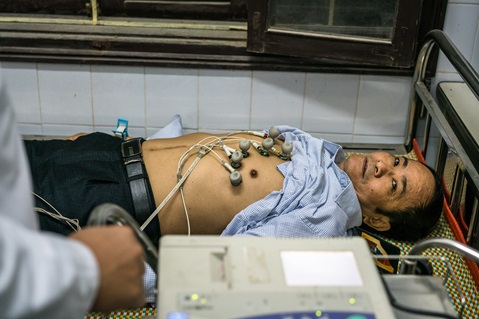most deaths related to cardiovascular disease occur after what age?

Cardiovascular diseases
Cardiovascular diseases (CVDs) are the leading cause of death globally, taking an estimated 17.9 1000000 lives each year. CVDs are a group of disorders of the center and claret vessels and include coronary heart disease, cerebrovascular disease, rheumatic centre disease and other weather condition. More than four out of five CVD deaths are due to heart attacks and strokes, and one third of these deaths occur prematurely in people under 70 years of age.
The virtually important behavioural risk factors of heart affliction and stroke are unhealthy nutrition, concrete inactivity, tobacco utilize and harmful use of booze. The effects of behavioural risk factors may show upwardly in individuals equally raised claret pressure, raised blood glucose, raised claret lipids, and overweight and obesity. These "intermediate risks factors" tin can exist measured in primary care facilities and bespeak an increased risk of heart assail, stroke, centre failure and other complications.
Abeyance of tobacco use, reduction of salt in the nutrition, eating more fruit and vegetables, regular physical activity and avoiding harmful utilise of alcohol take been shown to reduce the hazard of cardiovascular disease. Health policies that create conducive environments for making salubrious choices affordable and available are essential for motivating people to adopt and sustain healthy behaviours.
Identifying those at highest run a risk of CVDs and ensuring they receive appropriate treatment tin foreclose premature deaths. Access to noncommunicable disease medicines and basic wellness technologies in all primary health intendance facilities is essential to ensure that those in need receive treatment and counselling.
Heart assault and stroke
Often, in that location are no symptoms of the underlying disease of the claret vessels. A centre attack or stroke may exist the first sign of underlying disease. Symptoms of a eye attack include:
- hurting or discomfort in the heart of the chest; and/or
- pain or discomfort in the arms, the left shoulder, elbows, jaw, or back.
In addition the person may feel difficulty in breathing or shortness of breath; nausea or vomiting; light-headedness or faintness; a cold sweat; and turning pale. Women are more probable than men to have shortness of breath, nausea, vomiting, and back or jaw pain.
The near common symptom of a stroke is sudden weakness of the face, arm, or leg, most oft on one side of the body. Other symptoms include sudden onset of:
- numbness of the confront, arm, or leg, especially on one side of the body;
- confusion, difficulty speaking or understanding speech;
- difficulty seeing with i or both eyes;
- difficulty walking, dizziness and/or loss of residual or coordination;
- severe headache with no known cause; and/or
- fainting or unconsciousness.
People experiencing these symptoms should seek medical intendance immediately.
Rheumatic heart disease
Symptoms of rheumatic middle disease include: shortness of breath, fatigue, irregular heartbeats, chest pain and fainting. Symptoms of rheumatic fever (which tin crusade rheumatic heart disease if not treated) include: fever, pain and swelling of the joints, nausea, stomach cramps and vomiting.
WHO supports governments to foreclose, manage and monitor CVDs by developing global strategies to reduce the incidence, morbidity and mortality of these diseases. These strategies include reducing risk factors, developing standards of intendance, enhancing health system chapters to treat patients with CVD, and monitoring disease patterns and trends to inform national and global deportment.
The risk factors for CVD include behaviours such every bit tobacco use, an unhealthy diet, harmful utilise of booze and inadequate physical activity. They as well include physiological factors, including high blood pressure (hypertension), high blood cholesterol and high claret sugar or glucose, which are linked to underlying social determinants and drivers such every bit ageing, income and urbanization.
- Cardiovascular diseases (CVDs)
- Salt reduction
- Hypertension
- Prevention and control of noncommunicable diseases: guidelines for main health care in low resource settings
- Conducting systematic reviews to inform WHO Guidelines for the pharmacological handling of hypertension
- Noncommunicable diseases
Source: https://www.who.int/health-topics/cardiovascular-diseases/
0 Response to "most deaths related to cardiovascular disease occur after what age?"
Post a Comment